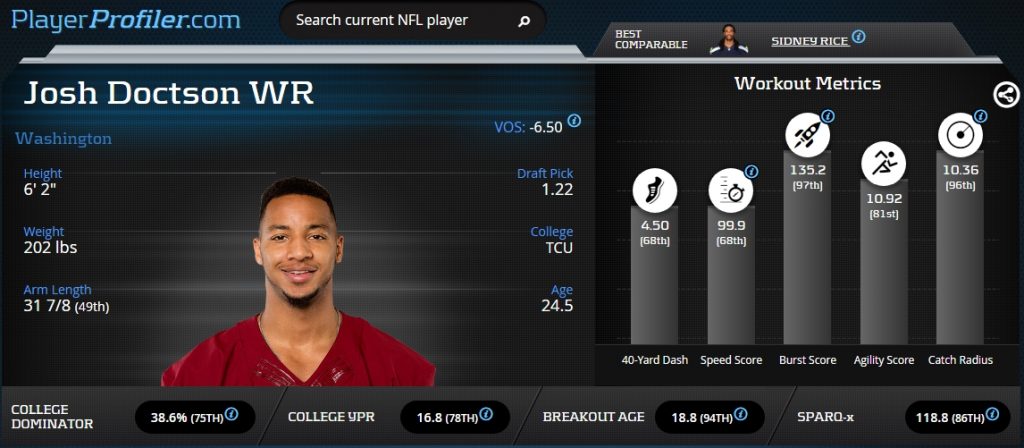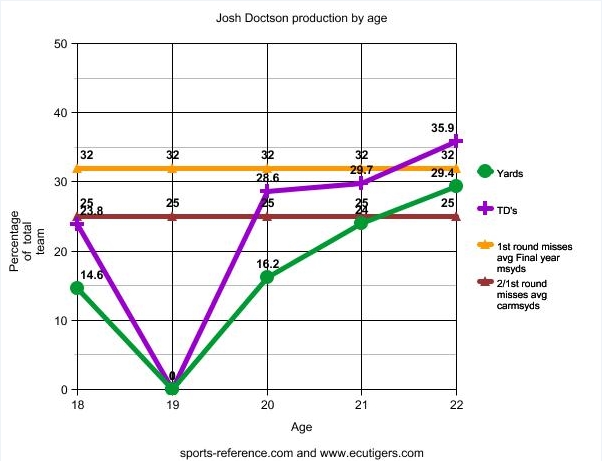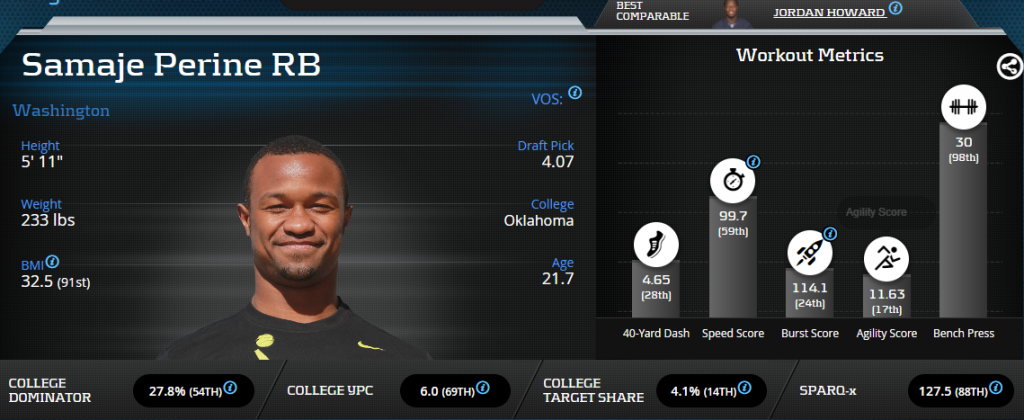Earlier this offseason Josh Doctson looked set to gain a significant role in a high volume offense. He was a clear buy-low opportunity after the departure of DeSean Jackson and Pierre Garcon. But the team then added Terrelle Pryor and everyone noticed the potential for Jamison Crowder. Finally, dominant tight end, Jordan Reed, has survived this long into the offseason without an injury and everyone’s excited about that. Now the growing consensus is that a consistent role will be hard to come by for Doctson in 2017. So, is that true, or is he still a buying opportunity?
First Round Woes
It’s easy to lose confidence in first round wide receivers lately. Excluding this year’s class, there have been 27 drafted in the first round since 2010. Exactly 13 of them averaged over 10 fantasy points per game, when on the field, in 2016. Five of those were drafted in 2014. Of course, not all hibernation periods are created equally.
There are not many prospects as productive and athletic as Doctson and none that have missed their first year to injury and then come back. There are some recent examples like Breshad Perriman and Kevin White. But too often he gets grouped in with the likes of Laquon Treadwell.
https://youtu.be/-qI3_9aIYHg
This also makes it hard to find a precedent to help us understand how his missing season could affect the rest of his career. As such we have to consider his college production and athleticism before his situation.
Uber Athleticism
Josh Doctson is athletic, that isn’t news. He is also tall, but so what, we all know that already. Ray Marzarella highlighted Doctson’s exceptional size-adjusted agility but also highlighted the unimpressive players Doctson compares to, because at 6-2, 202-pounds Doctson’s low BMI cohort features few truly successful NFL wide receivers.
I don’t have any concerns about Josh Doctson’s athleticism, but he is not as clear cut of a prototypical featured wide receiver as you may think. That’s not necessarily a bad thing since it’s increasingly common for flankers and other types of slot receivers to be consistent – often more consistent- fantasy produces. I wouldn’t be surprised if he could play any position in the NFL. However, because of his leaner frame, 10.36 (96th percentile) Catch Radius, and 10.92 (81st percentile) Agility Score the bar graph could blind us to his other potential role. Doctson could be one of the most prolific and dominating complementary receivers in the NFL.
Given this view, the real obstacles to a 2017 role are the rise of Jamison Crowder, the arrival of Terrelle Pryor, and the dominance of Jordan Reed. So the questions become;
- Are their targets available?
- Can he take advantage?
A Dominant College Producer
I want to consider Josh Doctson as a prospect as well as the potential role he could perform in 2017. So I can’t spend nearly enough time looking at his college production. I recommend Brian Tesch’s article here on playerprofiler examining how College Dominator ratings should be viewed depending school size. Also, check out Jon Moore and Jim Kloet’s work on rotoviz. In the meantime, here is a quick overview of how Doctson’s 38.6% (75th percentile) College Dominator rating breaks down.
The immediate concern on his rookie profile is that he was a 23-year-old prospect coming into the NFL. This is because he redshirted his age 19 season as he transferred from Wyoming into the Big-12 conference with TCU. He quickly picked up where he left off despite the jump in competition.
Even though his age 18 season was in a lower conference it is still impressive at such a young age. What’s not so immediately evident is that he was such a prolific touchdown scorer in college. The effect of being more productive in touchdowns (compared to yards) is a pet hobby (within a hobby) of mine. I don’t have enough stats to draw many conclusions yet. However, I did do a quick dive into where Josh Doctson was scoring his touchdowns.
According to cfbstats.com, Josh Doctson scored 16 out of his 29 total touchdowns while at TCU from within the opponent’s 20-yard line. This means that he scored 55-percent of his touchdowns in the red zone.
The leading receiver for TCU before Josh Doctson was Josh Boyce and between 2010 and 2012 he scored 9 out of 27 touchdowns in the red zone, 29.6-percent. Boyce is nowhere near the prospect Doctson is, but he’s equally athletic, if slightly smaller. It’s also worth noting that Doctson has a greater percentage of Redzone touchdowns than a lot of first round receivers, here’s a sample:
College usage does not cleanly translate into NFL usage. We don’t – and won’t till we see it – know how Washington will deploy its receivers. However, since it is the only clear sample of what Josh Doctson can do on a football field I think it’s important to note that the 6-2 wider receiver with a 10.36 (96th percentile) Catch Radius is incredibly comfortable in the red zone.
Vacated Targets
Until a player of Doctson’s calibre proves he can’t play in the NFL, we should hold onto our initial evaluation. Opportunity slides towards first rounders until they prove they can’t handle it. So, are there a whole bunch of red zone target’s laying around unanswered in Washington?
With the departure of Pierre Garcon and Desean Jackson, 40-percent of the offensive production is missing in 2017 along with 37.1-percent of the Target Share from 2016.
https://www.youtube.com/watch?v=y11aQDL3yZw
Josh Doctson and Terrelle Pryor offer some interesting contrasts. Even at 6-2, Doctson is shorter in comparison but dwarf’s Pryor with his 10.92 (81st percentile) Agility Score and a 135.2 (97th percentile) Burst Score. On the other hand, Pryor excels in pure speed, indicated by his 128.3 (99th percentile) Height Adjusted Speed Score. I think it’s clear Doctson can excel in a variety of roles that Pryor can not, but Pryor may be the more obvious outside and deep ball receiver of the pair.
The team also drafted Samaje Perine, a fairly unathletic running back, who put up 30 reps on the bench press at the combine (98th percentile.) There is a consensus among many in the fantasy community that Perine should gobble up short yardage and red zone touchdowns.
But Kirk Cousins has been No. 1 in air yards – yards the team has produced strictly thrown by the quarterback – for the last two years. Moreover, the team was 5th in passing attempts in the red zone in 2015, and 7th in 2016. I can’t imagine the addition of a 4th round running back, who was the later half of a committee in college, will change too much. However, even if the passing offense takes a step back it’s unlikely to fall below what Cousins did in his first year as a starter. In 2015 Washington threw for more that 4000 passing yards and managed 29 total passing touchdowns.
Red Zone Targets and Projections
Using PlayerProfiler’s Data Analysi Tool I took a look at the targets and completions at different points on the field in 2015 and 2016. While he is not the leader in overall yardage and touchdowns Jordan Reed is the clear cut first option in the passing game especially in the red zone. In the last two years, Reed has led the offense in receptions (153), red zone receptions (25), and red zone targets (37). While we think of him as an injury risk – he is – he has played in 9, 11, 14, and 12 games since 2013 leaving fewer games on the table then you might think.
Pierre Garcon has been the second most common option in the red zone. He totaled the second most red zone targets (30) in the last two years. With Pierre Garcon and Desean Jackson‘s departure, there are significant receptions and targets left unaccounted for in 2017.While we expect Jamison Crowder to take a step forward next season, how much of these missing numbers can he actually take over? While he has become a reliable option for Kirk Cousins it’s unlikely that he will account for all of his own targets in addition to all of DeSean Jackson‘s and/or Pierre Garcon‘s. If we elevate him to 120 targets, a minimum for a wide receiver 1, that leaves 155 targets up for grabs. If Terrelle Pryor were to take on the entirety of Jackson’s role, that still leaves 81 targets.
https://www.youtube.com/watch?v=xzlJxE5jjwo
Is this enough to make Josh Doctson a reliable fantasy starter in 2017? Jamison Crowder had 78 targets in 2015 in the same offence and he was relevant, if inconsistent, for fantasy. If we push this projection a little further, we can imagine Doctson having Crowders volume level of touches in 2015. So how did Crowder do in the red zone that year?
Jamison crowded converted 12 Redzone targets into 5 receptions in 2015 – a year where he scored 4 touchdowns. In 2017 Josh Doctson wouldn’t need to get more Redzone targets, he’d just have to take advantage of them more often. While applying the averages to this one year isn’t perfect, it’s also true that Washington’s 2015 passing volume is the lowest example of the two – 4166 yards – 800 fewer than in 2016. So while it exaggerates the floor for Josh Doctson, it also underplays the upside.
Check out Josh Doctson on the Updated PlayerProfiler Seasonal & Dynasty Rankings:
As a middle ground, I don’t think it’s unreasonable. But I do think it’s exciting for Josh Doctson‘s potential role in 2017.
Conclusion
For Josh Doctson to have a valuable fantasy season we don’t need an increase in passing volume. We don’t need him to outpace Terrelle Pryor or Jamison Crowder. All that would need to happen is for this historically great red zone receiver to catch half of his red zone targets.
Given Doctson’s exceptional prospect profile, I’m willing to bet on the potential upside in this offense. Josh Doctson could very well find a fantasy significant role in 2017. Doctson’s ability to ascend will depend on the health and efficiency Washington’s other receivers, and how much volume Kirk Cousins, in a contract year, generates after the team invested in the running game this offseason.







![[JordanReed]-TE-Redskins](https://www.playerprofiler.com/wp-content/uploads/2015/08/JordanReed-PlayerProfiler.jpg)




